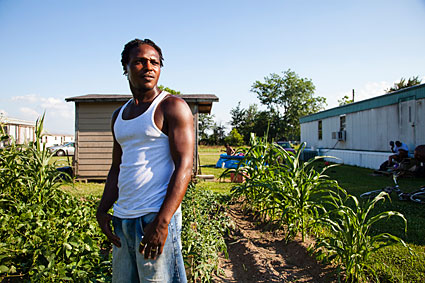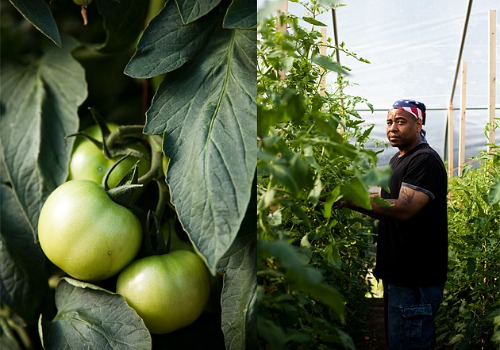January 2011 update: Many of the photos have been removed from this series so they can be published in a Breaking Through Concrete book, forthcoming this year from UC Press.
East New Orleans is lush and crumbling. Sometimes it feels like the built environment — the convenience stores, sugar factories, distant oil refineries, houses, brick apartments, parking-lot pavement — is no different than the vegetation: all bloom and decay, the life cycle spinning in time lapse.
Between Lake Pontchartrain and Lake Borgne, a lagoon inlet of the Gulf of Mexico, and about 10 miles east, Chef Menteur Highway runs for almost 40 miles across the Rigolets (rig-o-lees), a wild and undeveloped tract of pine forests and swamp. Strip malls cling like painter’s tape to the side of the highway, and between the asphalt and behind it, the wetland jungle seems to breathe its hot, wet air onto everything.
On Chef Menteur clings Village de l’Est, a neighborhood of vinyl-sided or light-colored brick ranch houses in a perfectly mid-century suburban layout with sidewalks, a few main avenues, and a couple shopping centers. A low mound on the north side of town, covered in tangled weeds and shrubs, marks the levee that holds in the Pontchartrain overflow.
Six thousand Vietnamese people live in this American village. The Vietnamese moved here with the Catholic Church in 1975 following the Vietnam War. Many were fishermen, and the nearby Gulf offered a work environment similar to their homeland. They also went to work in factories, hotels, and restaurants throughout New Orleans. Everyone, especially the elderly, knew how to grow things — that’s what they did back home. In their little square suburban backyards, they grew vegetables and fruits from seeds brought over from Vietnam. Some even crossed the levee and planted in that no-man’s-land. The wet fields, Delta soils, and thick, heavy air accommodated the same plants they grew in Vietnam.
Katrina hit Village de l’Est hard. A commitment to return to their homes following the flood and a rock-solid work ethic helped speed recovery, but it was the talent for growing their own food in community spaces and backyards that really guaranteed it.
My Tran works with the Mary Queen of Vietnam Church, the strongest entity in the community (90% Catholic, 10% Buddhist). Most of the elderly generation attend mass every morning from 6:30 to 7:30 a.m. My’s parents arrived here with the rest of the influx in ’75. They farm a plot in the community space along a black-water canal. In their conical straw hats, with banana leaves silhouetted against the hazy blue sky, water lilies choking the still canal, and a hundred shades of green surrounding them, the scene could be frozen on a Vietnam postcard. But the stories of hard work and scrappiness sound like the American Dream.
It’s just what they do. There’s soil and there’s sun and there’s water. Why wouldn’t you grow food there?
Years ago Nu and Thang Nguyen fed their family of nine children and still had enough left over to sell at the local market and to restaurants.“When we were younger, my parents grew veggies for home and for sale at market. They made over 50% of their income from the market sales,” says My. “They came here with no education, no language. Dad was a plumber and Mom cut grass for minimum wage. They tended the garden at nights and on weekends. My grandfather did the original farming — he passed it on to my parents.” All nine of the Tran kids went to college.
Since the ’70s, the food economy here has been largely a local one. Backyards produce enough for the family’s own consumption and more: they sell the excess to the local Pho restaurants and food markets. Without stringent regulations or organic certifications, the Saturday open-air farmers market still welcomes all comers. It looks and acts like a Vietnamese marketplace.
The Minh Canh grocery store off Alcee Fortier Street too could be transplanted straight from Vietnam. I can’t recognize most of the items. Fresh produce — mainly greens –- sit in boxes scattered about. There’s a buzz in here, the type of movement and noise that seems both chaotic and comfortable.
Here’s a short video we shot in the store:
After walking through some backyards overflowing with greens, potatoes, and fruits, and then eating the produce at the nearby Pho restaurant, Dong Phuong, and seeing it sold at Minh Canh, I have to say: This place feels like the model for sustainable local food — although no one here calls it that. It’s just what they do. There’s soil and there’s sun and there’s water. Why wouldn’t you grow food there?
On our final afternoon, we meet with Father Luke Nguyen. He’s an assistant to Father Nguyen (who is traveling in Vietnam), the charismatic leader of the church and community who’s credited with many of the progressive ideas coming from this community. Father Luke is an energetic man in his own right. He takes time out from his priestly duties to show us gardens and introduce us to residents. In each home we visit, we are offered cold water and sodas and invited to sit in the large, open, spotlessly clean living room with shiny, white-tiled floors and portraits of family members on the walls.
I ask Father Luke if the gardening will survive this generation of elderly. Are flat-screen TVs and fast food — the dark side of the American Dream — going to bulldoze the native knowledge and amputate the green thumbs? He doesn’t see it that way. It’s not just this elderly generation that wants to farm and enjoys being outside gardening and raising food. It’s just the elders. Period. There will always be elders. Other retirees in our culture pass the time playing bridge, tennis, golf, or volunteering at parks, etc. In the Vietnamese community, the elderly and retired stay busy growing food.
This turns all my notions of continuity and sustainability on their head. In Village de l’Est, they encourage the young’uns to be professionals, to work and raise their families. When they’ve retired, then they can dig in, connect with their heritage, and grow food.
Maybe this is a model we can learn from.



